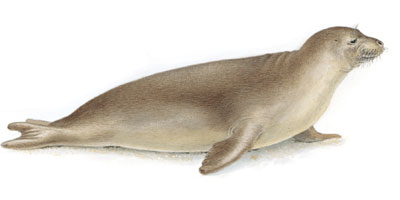Once plentiful, the Caribbean Monk Seal is officially declared extinct
Caribbean Monk Seal is officially declared extinct
Jeremy Hance, mongabay.com
June 9, 2008
Passenger pigeon of the sea
|
|
The NOAA fish service has officially declared the Caribbean Monk Seal extinct. The seal–the first to go extinct by human causes–has not had a confirmed sighting for fifty-six year. Many scientists believe sightings that have followed the last confirmation were probably of Hooded Seals and not the Caribbean Monk.
The seal used to tread the waters of not only the Caribbean, but also the Western Atlantic, the shores of South-Eastern USA, and the Gulf of Mexico. Unlike many animals facing extinction today due to habitat loss or invasive species, the Caribbean Monk Seal fell prey to over hunting. They were easy to slaughter as they came ashore on low sandy beaches and according to contemporary writers showed little fear of humans. From contemporaries the seal’s early abundance is clear. “The Bahama Islands are filled with seals; sometimes fishers will catch one hundred in a night,” wrote a traveler named H. Sloan in the early 1700s.
 Artwork by Sandra Doyle/Wildlife Art Ltd. Courtesy of the New York State Museum. |
Little is known about the natural history of the Caribbean Monk Seal, since its numbers were heavily depleted before science took an interest. The species was killed both for meat and oil obtained from its fat.
Using the announcement of the extinction to draw attention to other endangered monk seals, NOAA marine biologist Kyle Baker issued a warning this week. “Worldwide, populations of the two remaining monk seal species are declining. We hope we’ve learned from the extinction of Caribbean monk seals, and can provide stronger protection for their Hawaiian and Mediterranean relatives.”
According to NOAA (National Oceanic and Atmospheric Administration) statistics, Hawaiian Monk Seals are declining at rates of four percent annually. Their current population is estimated at 1,200. The threats facing the Hawaiian Monk Seal are numerous and complex: they become entangled and drowned in marine debris and fishing nests, many beaches where they historically have given birth have eroded, and once born their infants face immediate food-shortages. Despite its name, the species can no longer be found on the Hawaiian Islands of Oahu and Kauai.
The situation for the Mediterranean Monk Seal is even more dire. Classified by the IUCN as critically endangered, the species is thought to have a population of only 500 individuals left. The seal has suffered greatly in the past by intentional killings from local fishermen. More recently it is at risk from algae blooms, disease, drowning in fishing lines, and habitat loss. In 1997, tragedy struck when two-thirds was lost when the population in Cabo Blanco collapsed in a two-month span. The cause of this catastrophic decline is still unknown, but disease or algae blooms are the most commonly believed sources.
The Caribbean Monk Seal was more a victim of the 17th-19th Centuries than the century in which it went extinct. Like the Passenger Pigeon and the American Bison it was slaughtered in great numbers for food and sport during an historical period of great colonization. Despite the fact that the Caribbean Monk Seal has been on extinct species lists for decades, the NOAA spent a final five years searching for any sign of the lost seal before making an official announcement of its extinction.